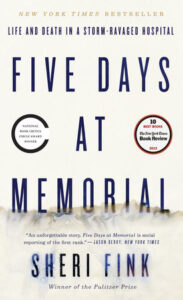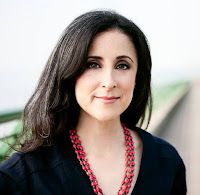By Sheri Fink
 Six days after Hurricane Katrina dissipated on Aug. 31, 2005, MSNBC cameraman Tony Zumbado paddled a kayak to Memorial Medical Center.
Six days after Hurricane Katrina dissipated on Aug. 31, 2005, MSNBC cameraman Tony Zumbado paddled a kayak to Memorial Medical Center.
He followed the smell of death to a chapel with a sign duct-taped to the door saying, “Do Not Enter.” Inside were 12 bodies.
When a disaster mortuary team arrived on Sept. 11, 2005, more than a week after staff and living patients had been evacuated, a total of 45 bodies were recovered from the chapel, morgues, hallways and emergency room.
No other New Orleans had as high a body count as Memorial did.
Soon, allegations emerged that at least nine patients in a special unit on the seventh floor, where many elderly and seriously ill patients were cared for, had died under suspicious circumstances and may have been given a lethal combination of drugs.
Author Sheri Fink doesn’t begin her story here. She begins with the party-like atmosphere as staff check in by noon, Sunday, Aug. 28, 2005, ahead of the hurricane. They bring kids, parents and pets as well as well-stocked coolers and grocery sacks stuffed with snacks.
Veterans of Gulf Coast hurricanes, staff viewed Memorial as a safe place to be during the hurricane. The hospital had withstood Hurricane Betsy in 1965, after all.
But Hurricane Katrina was a storm of a different order. The 79-year-old hospital, built just three feet above sea level, had always been prone to flooding. Months before Katrina, Director of Plant Operations Eric Yancovich had met with the U. S. Army Corps of Engineers. He’d calculated that it would take less than four feet of street flooding for water to begin to flow into the hospital. Very little more and most of the medical center would be disabled. Although Yancovich informed his superiors of this, the massive amounts of money required to fix this simply weren’t there.
By 4:30 a.m. Monday, Aug. 29, 2005, the winds shattered the windows of the medical center. Water flowed into the basement. The next day martial law was declared in neighboring Jefferson Parish. Nearby Lake Pontchartrain overflowed into city streets. The medical center became an island. Authorities told staff to prepare for at least 15 feet of water.
The hospital had a 20-year-old helipad with electric signal lights on a parking garage roof. Reaching it, required climbing metal stairs to a platform without guard rails. A large helicopter appeared and mistook the staff exploring the helipad for signaling it to pick up patients. Newborn babies were selected to go in that first unannounced helicopter.
Poor, uncoordinated communications with various disaster emergency entities made it impossible to tell when or if another helicopter was coming.
Tenet, the Dallas-based corporation that owned Memorial, believed that the National Guard was coordinating relief efforts and even declined using aeromedical helicopters from its Atlanta Medical Center to evacuate patients from Memorial.
Patients were carried down flights of stairs, lifted through a hole in a wall and settled on the floor of a parking garage to wait for evacuation. Around this time, triaging protocols changed from trying to get the sickest patients out first to holding patients with a “Do Not Resuscitate Order” for last.
By 2 a.m. Wednesday, Aug. 31, 2005, the back-up generators failed. This left the hospital with no air conditioning, no elevators, and no electrically powered ventilators for patients. In the morning, the water stopped flowing from taps, and toilets backed up.
An heroic group of outside volunteers brought airboats to the medical center and were able to evacuate some patients and staff to higher ground. But from there, evacuees were on their own without transportation, food or water.
People who had remained at the hospital to be with loved ones were told, sometimes at gunpoint, that they had to get into boats to be evacuated from the hospital.
The night echoed with gunshots, shouts and blaring car alarms.
On Thursday, Sept. 1, 2005, the nurses and staff of the LifeCare floor were told that their patients were going to be medicated. Dr. Anna Pou and two nurses were seen administering morphine and other drugs to a number of patients. Ironically, patients were still being evacuated by helicopter from Memorial.
Here, Dr. Fink’s exhaustive — and exhausting — chronicle shifts to the investigation by Assistant Attorney General Arthur “Butch” Schafer and Special Agent Virginia Rider into the allegations of euthanasia.
Dr. Anna Pou, a highly regarded surgeon from an old New Orleans family, and two nurses become the focus of their investigation.
When forensic pathologists compared toxicological test results to patient charts, it became apparent that at least 17 patients were given a combination of drugs that almost certainly killed them. Some were given large doses of drugs that had already been prescribed to them; others had never before (according to their medical records) been given the drugs that were found in their tissue samples.
Many might not have survived the harrowing evacuation process. But what is troubling to many is that the drugs were given just as helicopter evacuations were starting to run smoothly.
As the issue of what happened and why became increasingly political, the legal-judicial inquiry took a surprising turn.
Dr. Fink is eminently qualified to report on medical responses in disastrous situations. After completing medical school, she worked in a war zone hospital in Srebrencia, Bosnia-Herzegovina. With International Medical Corps, she worked in Haiti, Iraq, Bosnia, Macedonia and Mozambique as a physician. As medical reporter, she covered the 2014 Ebola virus epidemic in West Africa.
She spends the final chapter of her book discussing what was — and wasn’t learned about preparing for worst-case scenarios in disasters when Plan A fails. This book is difficult to read, but it raises challenging questions about rationing health care in a disaster.
One doctor who was adamantly opposed when euthanasia was brought up at Memorial was evacuated to an airport in Texas. As he waited for rescue from there, he could look out at patients in wheelchairs and lying on the floor in need of medical care, water and food. He clearly saw that many of the most fragile patients at Memorial could not have survived the evacuation. For him, the question was how were triage decisions made at Memorial and were patients robbed of an opportunity to survive.
As Dr. Fink points out numerous times research has shown that the patients doctors believe to be most vulnerable may be surprisingly resilient. Equally surprising are decisions that patients themselves or their family members would have made if they had been involved in triage decisions.
One of the most fascinating sections of the book compares Charity Hospital to Memorial. Charity had more patients, older facilities, and a lower staff-to-patient ratio, yet only 10 patients died there. The teamwork of staff, many veterans of the Vietnam War, the creativity in coming up with work arounds and an adherence to formal schedules all helped create a situation that allowed patients to survive better than they would have at Memorial.
Black and white, absolute rights and wrongs are hard to find in these extreme conditions. There’s much to learn from here. Perhaps the clearest wrong about what happened at Memorial over those five days was the failure of the legal system to provide for an open discussion and debate about the decisions made.
About the Author: Sheri Fink, MD, PhD
FIVE DAYS AT MEMORIAL is an expansion of Sheri Fink’s Pulitzer Prize-winning article “The Deadly Choices at Memorial,” published in The New York Times Magazine in August 2009.
The book, published in 2013) won the National Book Critics Circle Award for Nonfiction and the Los Angeles Times Book Prize for Current Interest that year. It also won the 2014 Ridenhour Book Prize and the 2015 PEN/John Kenneth Galbraith Award.
She was also a member of The New York Times reporting team that received the 2015 Pulitzer Prize for International Reporting for coverage of the 2014 Ebola virus epidemic in west Africa.
Her reporting has also won the National Magazine Award and the Overseas Press Club Lowell Thomas Award, among other prizes.
Dr. Fink earned her medical degree and a doctorate in neuroscience from Stanford University. She skipped her medical school graduation to assist refugees on the Kosovo-Macedonia border during the war in Kosovo. Working with the International Medical Corps, she also worked in Haiti, Iraq, Bosnia, Macedonia and Mozambique.
Her first book, WAR HOSPITAL: A TRUE STORY OF SURGERY AND SURVIVAL, is about medical professionals under siege during the genocide in Srebrenica, Bosnia-Herzegovina.
Born in Detroit, her father was a journalist who wrote for the Detroit News and later became a lawyer.



